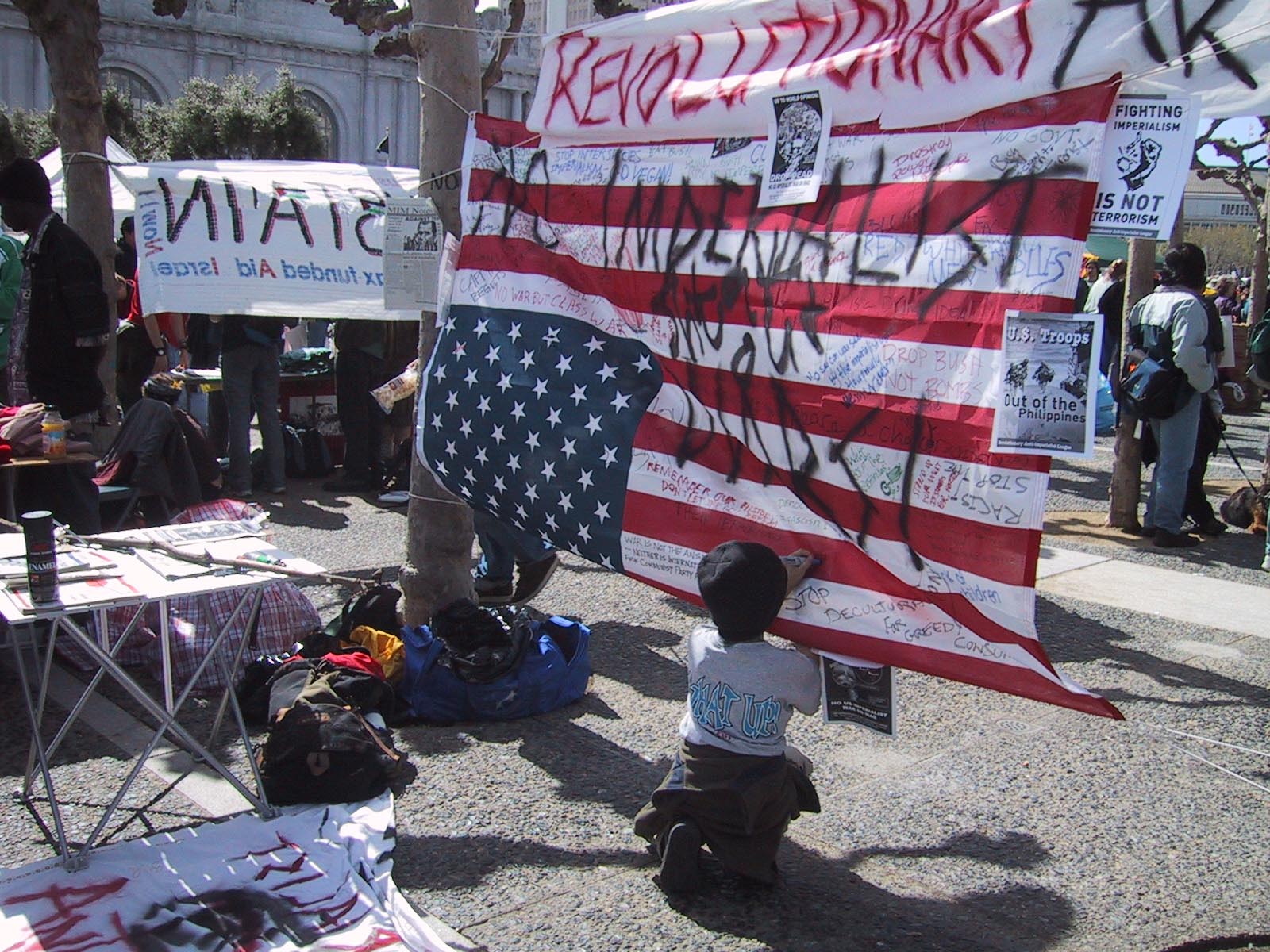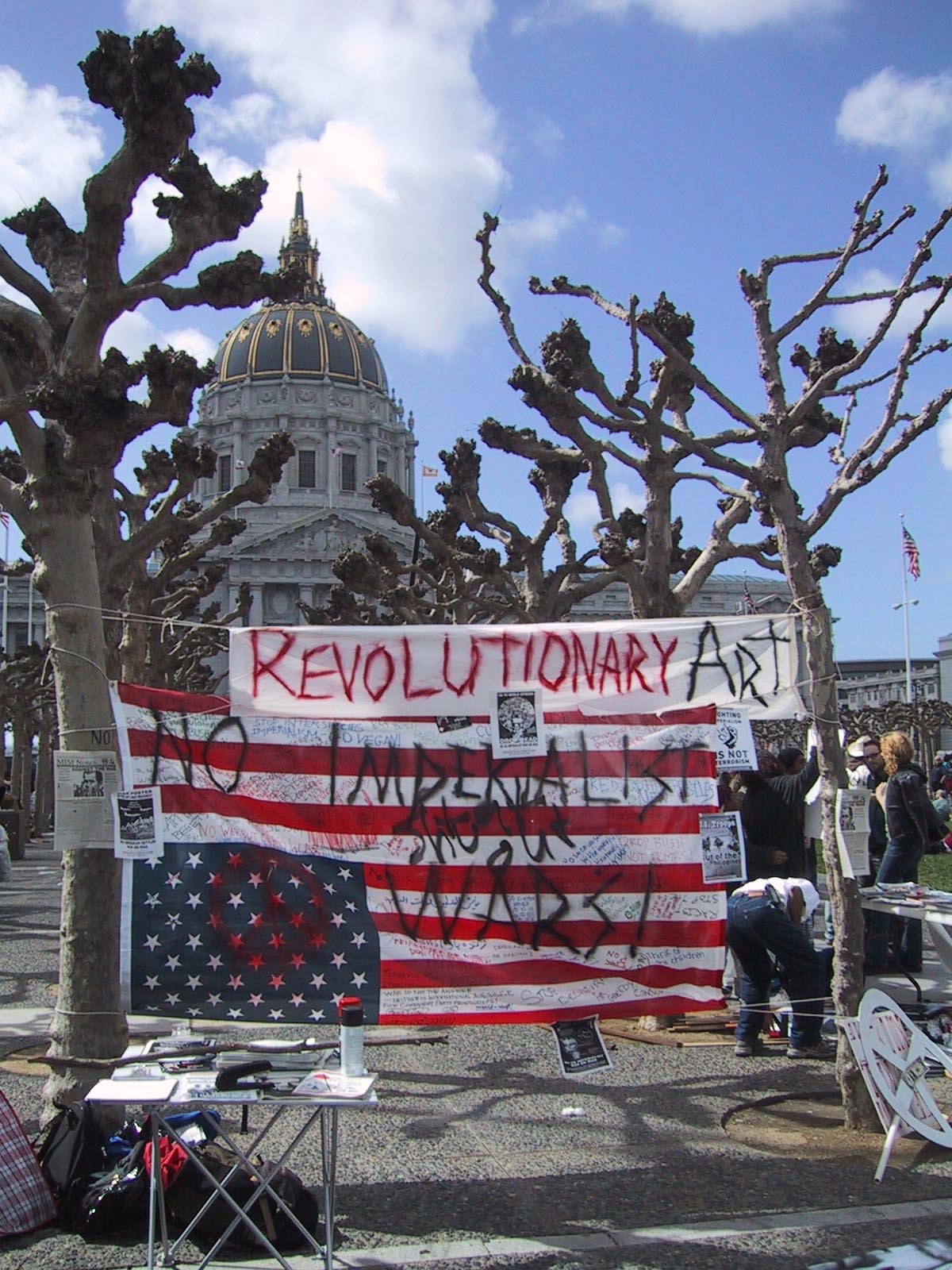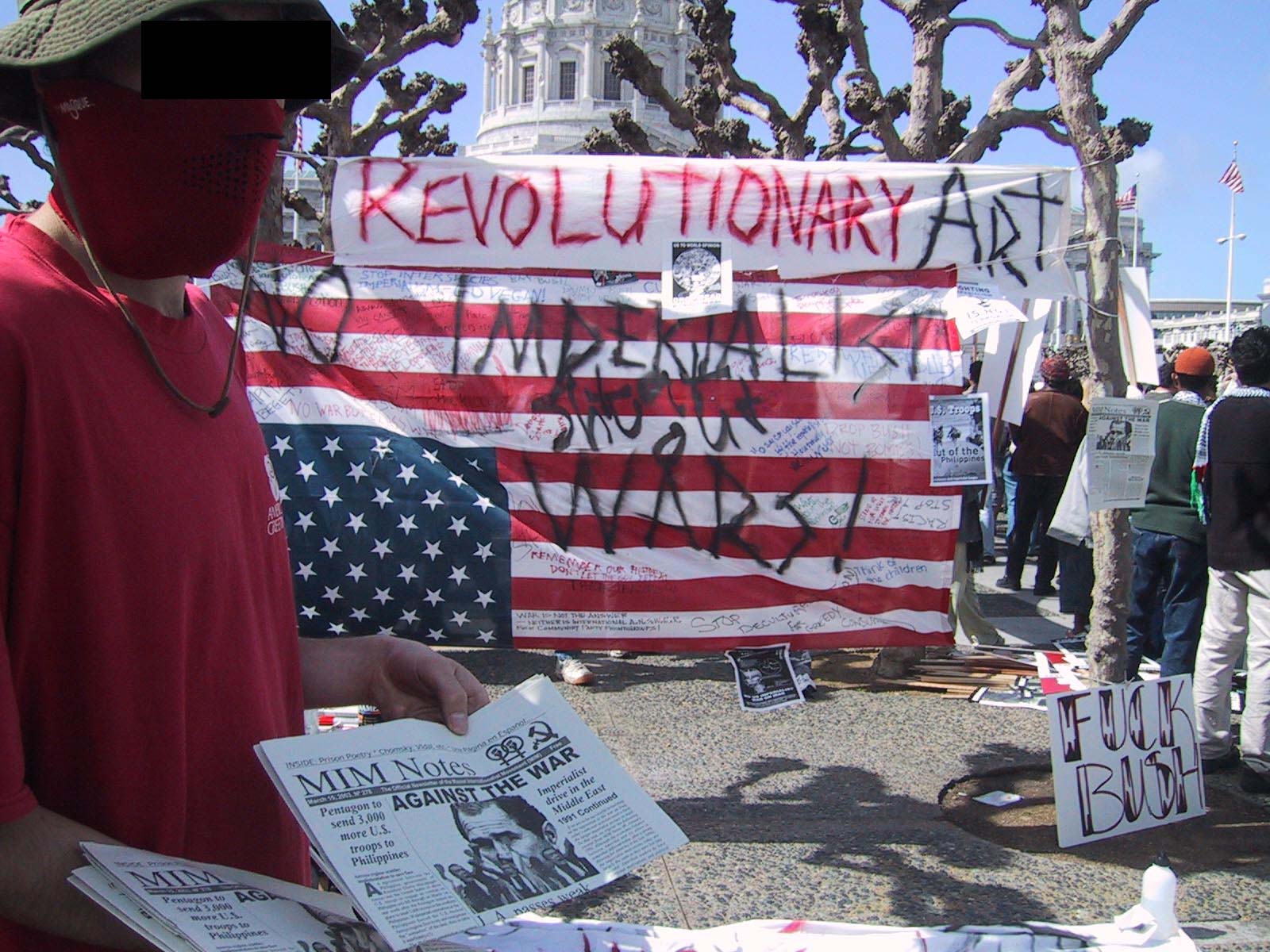MIM and RAIL organize revolutionary art against the war
San Francisco-- Around 80,000 people joined the March 15 anti-war protest
here. The numbers at the rally were lower than other recent protests, but
about 2000 people participated in a "break away" march (not following the
permitted route). Arrests were far more numerous than at past rallies with
close to 200 people ending up in jail, including several tourists and movie
goers who did nothing more than end up on the wrong sidewalk at the wrong
time. San Francisco appears to be criminalizing the act of protesting the war
outside of the confines of a permitted march.
At the pre-march rally MIM and RAIL put up a participatory revolutionary art display. On an Amerikkkan flag we sprayed painted "No Imperialist Wars!" and
attached RAIL flyers and stickers opposing the war in Iraq and imperialist
violence. Many people stopped to look at and take pictures of the display. We
handed out MIM Notes to everyone who passed by, explaining that the paper
represents our opinion of Amerikan imperialism and we invited others to
express their opinions on the Amerikan flag. We had markers, spray paint, a
knife and other supplies on hand. Improvisations included burning parts of
the flag and an offer by one protester to wipe his ass with it.
display. On an Amerikkkan flag we sprayed painted "No Imperialist Wars!" and
attached RAIL flyers and stickers opposing the war in Iraq and imperialist
violence. Many people stopped to look at and take pictures of the display. We
handed out MIM Notes to everyone who passed by, explaining that the paper
represents our opinion of Amerikan imperialism and we invited others to
express their opinions on the Amerikan flag. We had markers, spray paint, a
knife and other supplies on hand. Improvisations included burning parts of
the flag and an offer by one protester to wipe his ass with it.
The revolutionary art project was very popular. Thousands of people stopped
to read what was written on the flag and many of them stepped up to express
their anger at the Amerikan system. The majority of rally participants
promoted pacifist or liberal anti-war sentiments. The revolutionary art
project gave us a chance to introduce these people to an anti-imperialist
perspective through MIM Notes while uniting with them in opposition to this
war on Iraq. We also connected the struggle to an action that even those who
did not want to desecrate the flag could take: we asked people to sign a
petition defending one of the many victims of the U.$. terror campaign, Jose
Maria Sison, a Filipino revolutionary leader in exile in the Netherlands.
Overall our revolutionary art project succeeded in gaining much attention for
the MIM and RAIL literature table and interest in MIM Notes while also giving
normally passive rally participants an opportunity to express their views on
imperialism. But we failed to plan for a way to clearly demarcate our work as
a project of MIM and RAIL. We did attach copies of MIM Notes to the trees
next to the flag, but the banner above the flag only read "revolutionary art"
so those who passed by just taking pictures probably were not aware of our
intention. We did attempt to remedy this problem by approaching everyone who
noticed the display to offer them MIM Notes and explain the purpose of the
project.
There were a number of people who wrote statements on the flag that agree
with MIM and RAIL's revolutionary anti-imperialism including: "capitalism
begets violence", "notice media manipulation by Bush administration", "O say
can you see, by the imperialist light, how proudly we murder", "Bush and his
crew, international terrorists" and several statements in Arabic that
translated into support for the Palestinian peoples right to self-
determination.

Several who expressed their opinions on the flag represented anarchist
positions including those who wrote "No govt." But the largest group we
encountered were those who didn't see imperialism as the main enemy. These
pacifists or liberals had a wide range of reasons for opposing the war on
Iraq, from religion to patriotism.
We also saw a lot of signs blaming or targeting just President Bush, rather
than the system of imperialism that gives him power. And even worse, many
that implied George W. is evil only because his father, Bush Sr., raised him
that way. This individualism leads to misplaced anger and an incorrect focus
on the leader rather than the system that is causing tens of thousands of
people to die daily.
The strong support for pacifism and religion was bolstered by actor Martin
Sheen's speech. His introduction was greeted with loud cheers and a standing
ovation by the mostly seated crowd. He delivered something of a sermon,
calling on god to grant the activists the power to stand peacefully in
opposition to the war and praying for strength. During each pause the crowd
continued to cheer.
Anticipating the photographic attention, and also knowing that police
surveillance at rallies is strong, a few of the MIM and RAIL activists had
their faces covered. Several people stopped to ask us why we did this and
greeted our explanation that we intended to make it harder for the police to
repress revolutionaries, with understanding and support.
The March 12 issue of the San Francisco Bay Guardian (a local weekly
newspaper) ran an article on undercover cops monitoring peace protesters. At
recent anti-war rallies, "A group of four officers assigned to the Violent
Crimes Task Force--a unit that normally handles gang killings--carried out
the undercover operations. Dressed as protesters, the squad videotaped the
demonstrations and marched along Market Street in the large antiwar parades
as well as in the smaller, riotous 'breakaway' marches. They also made a
handful of arrests for vandalism."
The article goes on to explain: "The SFPD established strict guidelines on
surveillance after S.F. cop Tom Gerard, a former Central Intelligence Agency
operative, was caught spying on Bay Area leftists in 1992. Working with the
Anti-Defamation League, Gerard had compiled dossiers on some 7,000 radicals.

"According to the SFPD's spying rules, which remain in place today, police
must receive written permission from the 'Commanding Officer of the Special
Investigations Division, Deputy Chief of Investigations and the Chief of
Police' before mounting a surveillance operation. In the files we reviewed
there's no mention of the appropriate command staff being involved in the
recent undercover operations. "
Activists should know that it doesn't matter if the police have policies
supposedly governing their spy operations. The police and FBI have a long
history of undercover surveillance and worse including infiltration,
disruption and violence, against anti-imperialist activists. We can make it
harder for them by disguising ourselves at public events, refusing to give
out unnecessary persynal information to other people (including our real
names), and taking care using our phones and internet connections. We should
not let fear keep us from organizing, but we need to be realistic about the
power the government has and the existence of spying and counterintelligence
operations.
return to SF news
 display. On an Amerikkkan flag we sprayed painted "No Imperialist Wars!" and
attached RAIL flyers and stickers opposing the war in Iraq and imperialist
violence. Many people stopped to look at and take pictures of the display. We
handed out MIM Notes to everyone who passed by, explaining that the paper
represents our opinion of Amerikan imperialism and we invited others to
express their opinions on the Amerikan flag. We had markers, spray paint, a
knife and other supplies on hand. Improvisations included burning parts of
the flag and an offer by one protester to wipe his ass with it.
display. On an Amerikkkan flag we sprayed painted "No Imperialist Wars!" and
attached RAIL flyers and stickers opposing the war in Iraq and imperialist
violence. Many people stopped to look at and take pictures of the display. We
handed out MIM Notes to everyone who passed by, explaining that the paper
represents our opinion of Amerikan imperialism and we invited others to
express their opinions on the Amerikan flag. We had markers, spray paint, a
knife and other supplies on hand. Improvisations included burning parts of
the flag and an offer by one protester to wipe his ass with it.

